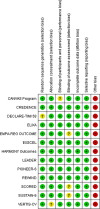Cardiovascular and renal outcomes with SGLT-2 inhibitors versus GLP-1 receptor agonists in patients with type 2 diabetes mellitus and chronic kidney disease: a systematic review and network meta-analysis
- PMID: 33413348
- PMCID: PMC7792332
- DOI: 10.1186/s12933-020-01197-z
Cardiovascular and renal outcomes with SGLT-2 inhibitors versus GLP-1 receptor agonists in patients with type 2 diabetes mellitus and chronic kidney disease: a systematic review and network meta-analysis
Abstract
Background: Emerging evidence suggests that sodium-glucose cotransporter-2 (SGLT-2) inhibitors and glucagon-like peptide-1 receptor agonists (GLP-1 RAs) are associated with decreased risk of cardiovascular and renal events in type 2 diabetes mellitus (DM) patients. However, no study to date has compared the effect of SGLT-2 inhibitors with that of GLP-1 RAs in type 2 DM patients with chronic kidney disease (CKD). We herein investigated the benefits of SGLT-2 inhibitors and GLP-1 RAs in CKD patients.
Methods: We performed a systematic literature search through November 2020. We selected randomized control trials that compared the risk of major adverse cardiovascular events (MACE) and a composite of renal outcomes. We performed a network meta-analysis to compare SGLT-2 inhibitors with GLP-1 RAs indirectly. Risk ratios (RRs) with corresponding 95% confidence intervals (CI) were synthesized.
Results: Thirteen studies were selected with a total of 32,949 patients. SGLT-2 inhibitors led to a risk reduction in MACE and renal events (RR [95% CI]; 0.85 [0.75-0.96] and 0.68 [0.59-0.78], respectively). However, GLP-1 RAs did not reduce the risk of cardiovascular or renal adverse events (RR 0.91 [0.80-1.04] and 0.86 [0.72-1.03], respectively). Compared to GLP-1 RAs, SGLT-2 inhibitors did not demonstrate a significant difference in MACE (RR 0.94 [0.78-1.12]), while SGLT-2 inhibitors were associated with a lower risk of renal events compared to GLP-1 RAs (RR 0.79 [0.63-0.99]). A sensitivity analysis revealed that GLP-1 analogues significantly decreased MACE when compared to placebo treatment (RR 0.81 [0.69-0.95]), while exendin-4 analogues did not (RR 1.03 [0.88-1.20]).
Conclusions: In patients with type 2 DM and CKD, SGLT-2 inhibitors were associated with a decreased risk of cardiovascular and renal events, but GLP-1 RAs were not. SGLT-2 inhibitors significantly decreased the risk of renal events compared to GLP-1 RAs. Among GLP-1 RAs, GLP-1 analogues showed a positive impact on cardiovascular and renal outcomes, while exendin-4 analogues did not.
Keywords: Cardiovascular disease; Chronic kidney disease; Diabetes mellitus; GLP-1 receptor agonist; Meta-analysis; Renal outcomes; SGLT2 inhibitors.
Conflict of interest statement
The authors declare that they have no competing interests.
Figures





References
-
- Federation ID: IDF Diabetes Atlas—9th Edition. 2019.
-
- Saran R, Robinson B, Abbott KC, Bragg-Gresham J, Chen X, Gipson D, Gu H, Hirth RA, Hutton D, Jin Y et al. US renal data system 2019 annual data report: epidemiology of kidney disease in the United States. Am J Kidney Dis. 2020;75(1S1):A6–A7. - PubMed
Publication types
MeSH terms
Substances
LinkOut - more resources
Full Text Sources
Other Literature Sources
Medical

